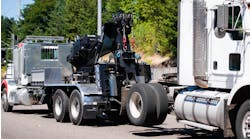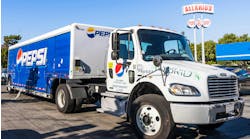When the California Air Resources Board (CARB) issued regulations aimed at reducing harmful emissions from existing diesel-powered vehicles operating in the state, it set in motion for fleets a process that has called for new vehicle choices and a significant investment. Among those impacted are the jointly managed fleets — with 6,000 vehicles and 1,200 pieces of equipment combined — operated by San Diego Gas & Electric Co. (SDG&E) and Southern California Gas Co. (SoCalGas). The two utilities are part of Sempra Energy.
“We're already beginning the process because it's important to stay out in front of the inevitable challenges that will arise,” says Hector Madariaga, director of environmental affairs. “Companies that wait until the deadline is looming will have a much tougher time bringing their fleets into compliance.”
The regulations affecting utility fleets apply to diesel-fueled trucks with a GVWR greater than 14,000 lbs. “We have 1,100 vehicles in that weight range and about half of them fall under retrofit or replacement requirements,” explains Madariaga. “By the end of 2013, our diesel fleet must be 100% compliant with regulations. Besides retrofitting 50% of our fleet with particulate filters, by 2013 we must have at least 20% of the units compliant with 2007 emissions standards and 30% compliant with 2010 emissions standards.”
Madariaga, who is spearheading the effort to ensure compliance with California's emissions requirements at SDG&E and SoCalGas, is a highly qualified environmental engineer who has worked for utilities since 1975. Most recently, he served as director of fleet services for the combined fleet operations.
IN SEARCH OF THE BEST
According to Madariaga, one of the issues is finding the best available technology for its retrofit compliance strategy. CARB has issued lists of approved solutions for each type of engine, and exhaust temperature profiling must be conducted to determine if active or passive systems are required.
Cost is also a consideration, and for SDG&E and SoCalGas, the investment required is estimated to be between $12,000 and $25,000 per vehicle. “It's a significant amount of money,” Madariaga says, “but we looked at the economics and considered that a new vehicle for our operation can cost $180,000, and that we cannot sell our existing vehicles for use in California or in some other parts of the country. Unless the truck is a 2002 model or older, or has very high mileage or engine hours, it may be worth it to retrofit the unit rather than purchase a new one.”
Madariaga says that it may also be worthwhile for SDG&E and SoCalGas to consider opportunities to use alternative-fueled vehicles. “With an extensive infrastructure in our operating territory, compressed natural gas (CNG) is a natural choice for us,” he says. “We are adding five CNG crew trucks to replace diesel vehicles and with new OEM options becoming available, we're looking to add at least 1,000 new CNG light-duty trucks over the next few years. If we deploy them in areas where CNG is in widespread use, higher utilization will help us realize a faster return on investment.”
Madariaga is now working with vehicle manufacturers, industry associations and air quality agencies to ensure that natural gas is part of the future for the SDG&E and SoCalGas fleets. Overall, the companies are meeting objectives by replacing sedans with CNG and hybrid vehicles, and 12 all-electric vehicles are being added at SDG&E.
“It's all about balance,” Madariaga states. “While we always take our obligation to be green seriously, we never lose sight of the need to ensure our fleet is reliable and cost-effective.”


